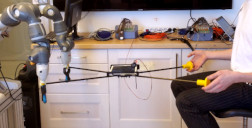Hauptinhalt
Topinformationen
Pressemeldung
Nr. 75 / 2021
11. August 2021 : Our brain distinguishes whether social partner is human or robot – Cognitive scientists at the University of Osnabrück identify neurophysiological foundations of human-machine interaction
When humans interact with robots, their brains are activated differently than when humans are asked to solve the same task with other humans. This is the result of an experimental international study led by cognitive scientists at Osnabrück University. This study has been published in Frontiers under the title "Coordinating With a Robot Partner Affects Neural Processing Related to Action Monitoring": https://www.frontiersin.org/articles/10.3389/fnbot.2021.686010
First authors are Artur Czeszumski, Anna Lisa Gert and Ashima Keshava, PhD students in the Neurobiopsychology lab of Prof. Dr. Peter König at Osnabrück University.
The team was interested in the cognitive processes that take place when humans interact with robots. "Robots increasingly play a role in our social landscape. They respond to human behavior. We wanted to know if the human brain processes interactions with a robot differently than interactions with another human," said Artur Czeszumski.
To do this, the researchers asked study participants to solve a task in interaction with a robot and to also solve the same task together with another human. As a duo, the goal was to make a virtual ball roll steadily in a circle on a tablet. During the completion of the task, brain activity was measured and evaluated via EEG.
With the robot, task completion was slower and more controlled overall, while the cognitive activity of the participants was particularly prominent during errors: If the ball drifted strongly from the circular path, the human and the robot had to coordinate again in order to bring the ball back onto the path. The measured brain activity of the participants was stronger during the coordination with the robot. The results in the task of correcting the resulting error together with the robot were similar to the brain activities known from "action monitoring". This is a cognitive process that continuously compares the expected results of an action with the intended results of the action.
"From this result, we see that humans systematically represent interactions with a robot or artificial intelligence differently than those with a human," Czeszumski said. "Our finding about the outcome orientation activated in the human brain is an important step for the further development of social robots and the precisely fitting programming of the interaction interface in human-machine interaction."
The EEG study was conducted together with partners in Stockholm/Sweden and the University of Stuttgart.
Link to publication: https://www.frontiersin.org/articles/10.3389/fnbot.2021.686010
Information for editors:
Artur Czeszumski
Osnabrück University
Institute for Cognitive Science
Phone: +49 541 969 2245
aczeszumski@uni-osnabrueck.de





